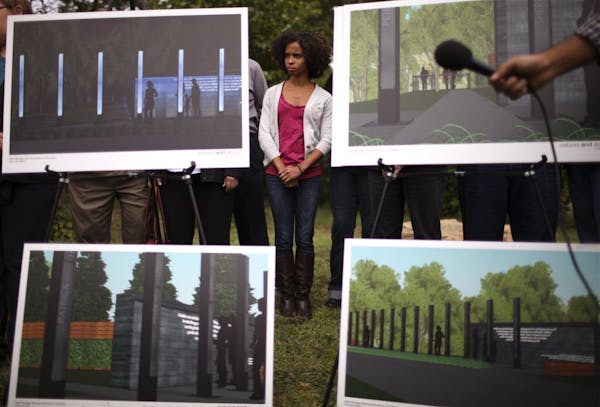Landscape architect Tom Oslund didn't design Gold Medal Park as a memorial. But hours after the Interstate 35W bridge collapsed in August 2007, that striking swath of green just east of the Guthrie Theater became one.
Mourners of victims of the tragedy processed up its spiral walkway, gathered at the top of its 32-foot-high mound in an outdoor room framed by amur maples, placed their flowers and mementos on the ground and the benches, and looked out on the collapsed bridge and the Mississippi River.
Such was the power of the place.
Scroll forward to a happier moment in Twin Cities public life -- April 12 of this year, when the Twins played their first game at Target Field. Thousands of fans funneled into the field from downtown Minneapolis via a welcoming plaza also designed by Oslund's Minneapolis firm. They passed by 40-foot-high metal bats, a bronzed fielder's glove big enough to sit in, and a giant metal screen seemingly made of tiny moving baseball cards.
The sense of delight was palpable.
Officed on Washington Avenue above a music shop, the nine-person Oslund and Associates has made an outsized impact on Minnesota public space.
At General Mills' corporate campus in Golden Valley, employees enjoy the serene expanse of a 35-acre landscape shaped to frame the classic modern glass and steel buildings and the company's outdoor art collection. The minimal, sculptural look of the new I-35W bridge owes much to Oslund's role on the design team.
Last week, the firm's final design for the I-35W Remembrance Garden was unveiled. Thirteen steel I-beams, each engraved with a name of one of the 13 who lost their lives, face a water wall with a polished surface engraved with the names of all those on the bridge that August day.
Oslund developed the original design for the memorial for a corner of Gold Medal Park, but uncertainty about the park's long-term future led to the iteration for a river bluff site across 11th Avenue S. on West River Parkway.
"I'm fascinated with the whole subject of memorials," said Oslund, 54. "They are heavy, emotionally riveting projects. I really enjoy them."
Memorials tap into the approach he brings to landscape architecture -- which he calls site design. He doesn't just shape the land; he seeks the meanings beneath the surface.
At Gold Medal Park, the 300-foot-diameter mound was inspired by the American Indian burial mounds along the Mississippi River's bluffs. The walkways snaking through the site mark paths that rivulets would take to the river.
"He likes to read between the lines of the site," said Nick Winton, a Minnesota-born Boston architect who met Oslund at Harvard Graduate School of Design. "He looks not at the obvious elements but the geological, historical and metaphorical elements."
For home-game crowds
Target Plaza may seem as far away from a memorial as a public space can get, but elements of the place evoke Twins history and add depth to what could be a landscape one-liner. The bronzed glove, for instance, marks a spot 520 feet away from home plate -- the length of Harmon Killebrew's longest home run.
Oslund said, "It sounds corny, but I must have seen 7,000 people get their pictures taken in it at the March open house."
The more metaphorical features are vintage Oslund. The tall morning glory- and hops-covered metal bats that light up when there is a Twins home run manage to be clever, minimal and functional at the same time. Benches lined up under a curving trellis soften the space and offer a place to perch out of the sun.
Oslund brought in his friend, artist Ned Kahn of Sebastopol, Calif., to design the wildly popular "Wind Veil" sculpture that keeps the plaza animated even when no one is around.
Made of anodized aluminum cards strung on stainless steel airplane cable, the kinetic sculpture recalls the human wave of the seventh-inning stretch, masks the giant blank wall of a city parking ramp, and infuses an urban site with the vagaries of light and wind.
Oslund says the firm has been criticized for the metal bats. "Some have said that's not landscape architecture," he said. "I see the discipline as one without limits.
"For me, it's the interesting connection between time, memory, space and awareness of where you are. Good public space needs to be something that resonates with people's spirit."
What's on the horizon in this era of few projects? Oslund will continue doing work for the college campuses he has master planned, including Carleton College and the University of Minnesota Duluth.
And he is competing with eight other firms for a major Minneapolis plum: the renovation of Peavey Plaza, the half-block between Orchestra Hall and Nicollet Mall. His team includes M. Paul Friedberg, the 1975 plaza's original designer, and Charles Birnbaum, director of the Cultural Landscape Foundation, which advocates for the preservation of significant landscapes.
"Like others, I'm very interested in what happens to Peavey Plaza," Oslund said. "It raises the question: What is a great Modern landscape?"
Linda Mack writes regularly about architecture.

Minnesota Sports Hall of Fame: A class-by-class list of all members

This retired journalist changed professional wrestling from Mankato

